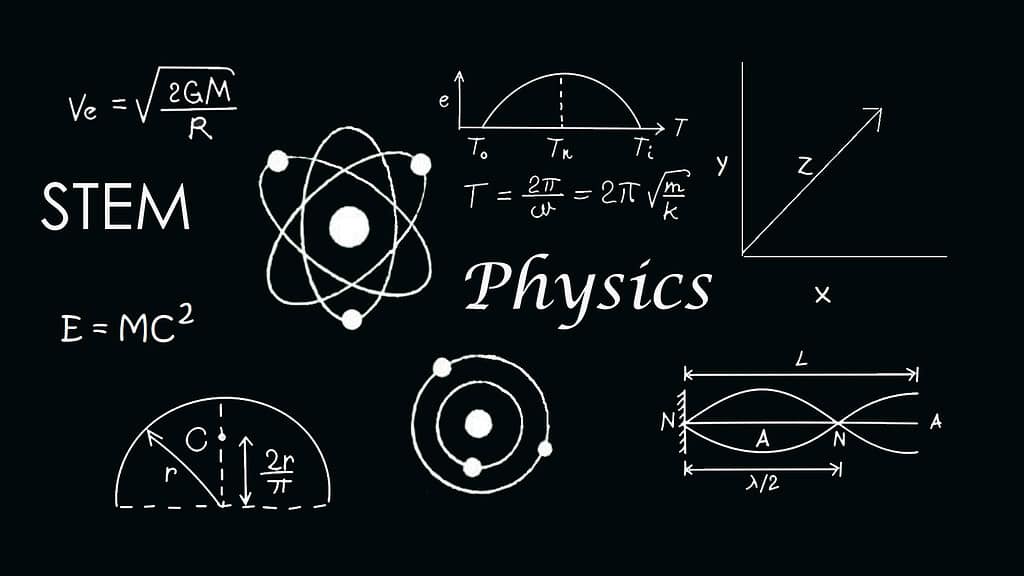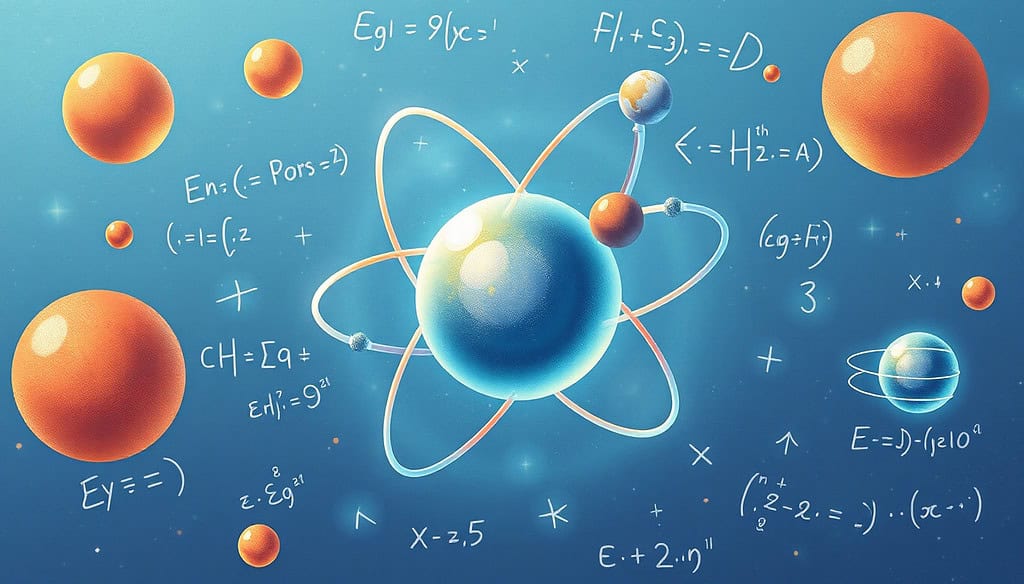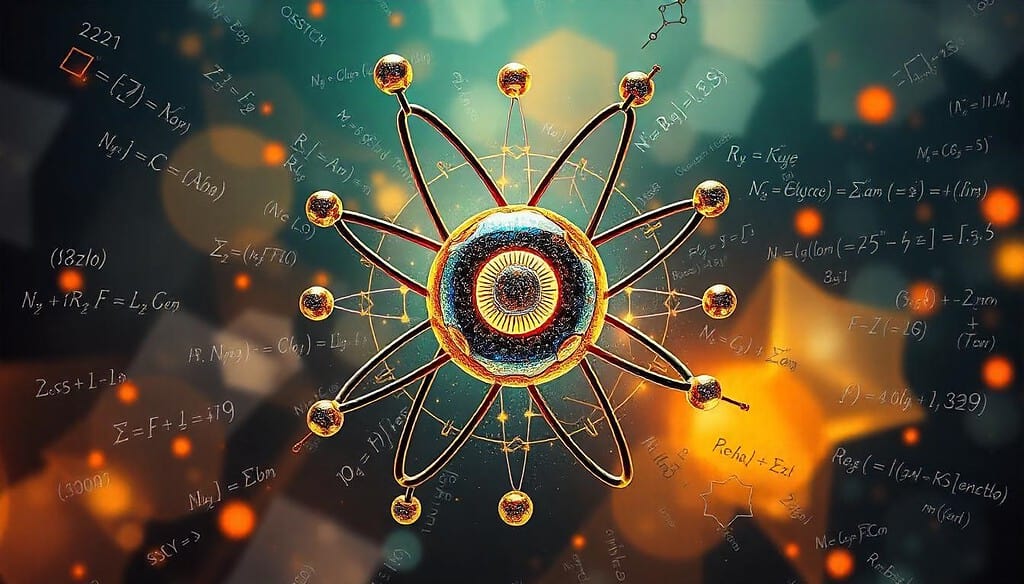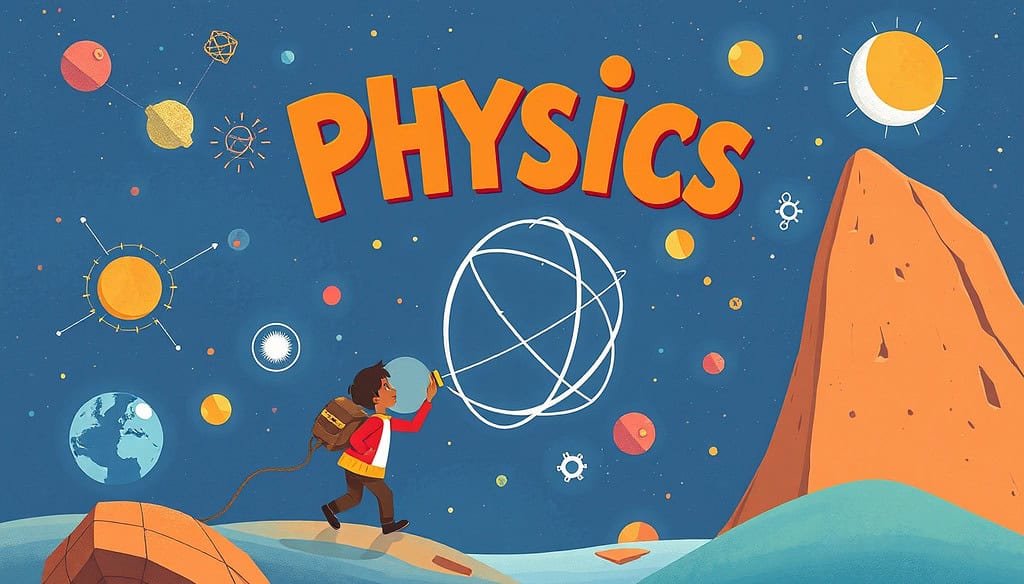Table of Contents
Physics: An Important STEM Subject

Physics stands as one of the most fundamental STEM subjects, shaping our understanding of the natural world and the laws governing it. It provides the foundation for exploring phenomena on scales from subatomic particles to galaxies, revealing the principles underlying everyday technologies and cosmic wonders alike. As a discipline, physics demands a unique blend of analytical thinking, mathematical precision, and conceptual creativity, making it both challenging and rewarding. It encourages students to approach problems systematically, fostering critical skills in logical reasoning, hypothesis testing, and data analysis, which are highly transferable across scientific fields.
At its core, physics is driven by curiosity about how the universe operates, from the forces that bind atoms together to the gravitational waves rippling across space. This expansive scope has led to countless discoveries, fueling advancements in technology and engineering. Innovations such as MRI machines, lasers, and quantum computers all trace their roots to breakthroughs in physics, underscoring its practical impact on society. Furthermore, physics plays an essential role in other scientific fields, including chemistry, biology, and environmental science, by offering insights that deepen our understanding of everything from molecular interactions to ecological dynamics.
Studying physics, however, can be demanding. Its mathematical rigor requires students to develop a solid grasp of algebra, calculus, and trigonometry, often pushing them beyond the typical boundaries of high school or even undergraduate mathematics. Additionally, physics problems frequently require abstract thinking, as concepts like wave-particle duality or relativity can be difficult to visualize. This combination of complexity and abstraction can deter some students, but for those who persist, physics offers a profound sense of accomplishment and intellectual fulfillment.
As we face global challenges such as climate change, energy sustainability, and space exploration, the contributions of physics continue to grow in relevance. Physicists are at the forefront of developing renewable energy technologies, advancing medical diagnostics, and paving the way for interplanetary travel. Thus, physics not only nurtures scientific inquiry but also empowers society to address pressing issues through technological innovation. Embracing physics as a field of study equips students not just with knowledge, but with a mindset oriented toward problem-solving and discovery. For anyone seeking to make a meaningful impact, physics offers an unparalleled opportunity to contribute to both scientific progress and societal welfare, proving that this ancient discipline is as relevant today as it has ever been.
8 Interesting Ways To Be Efficient At Physics

1. Master the Fundamentals First
In physics, a solid grasp of the fundamentals is crucial to developing a deep and efficient understanding of the subject. Mastering core concepts such as force, energy, motion, and fields lays the groundwork for more complex studies, enabling students to solve problems with clarity and confidence. Without a clear understanding of these basics, one might find it challenging to recognize patterns or relationships in advanced topics, leading to a lack of efficiency in both learning and problem-solving. To navigate physics with ease, it is essential to have these foundational elements fully integrated into one’s knowledge base, as they serve as building blocks for nearly every aspect of the field.
The importance of mastering the fundamentals can be compared to learning a new language. In language learning, basic grammar, vocabulary, and sentence structure are essential before one can form meaningful sentences and convey ideas effectively. Similarly, in physics, the fundamental principles act as the grammar and vocabulary of the subject. Without a complete understanding of these, students may find themselves unable to comprehend the larger “sentences” or theories that physics presents. As students move from fundamental principles to more complex equations and concepts, they are essentially layering new information on top of an existing framework. Each additional concept builds upon the previous one, and any gaps in fundamental knowledge can create difficulties when handling advanced ideas.
A practical approach to mastering these fundamentals is to consistently review and reinforce core concepts, even when studying advanced topics. For instance, when exploring advanced mechanics, regularly revisiting Newton’s laws can provide clarity and context. This habit of regularly revisiting and solidifying core principles prevents the fundamentals from becoming distant memories, ensuring they remain at the forefront of one’s thinking. Additionally, solving a wide range of fundamental problems can further reinforce one’s understanding. By practicing with a diverse array of scenarios, one can see how fundamental concepts apply in different contexts, which not only strengthens knowledge but also builds adaptability and speed in problem-solving.
Furthermore, developing a strong foundation in fundamental concepts also aids in recognizing common physics patterns across different areas. Once the basics are well understood, students can more quickly identify the relevant principles needed to tackle various problems, reducing the amount of time and effort spent on each one. This foundational understanding enables students to make accurate assumptions, apply relevant formulas, and move through problem-solving steps with ease. Ultimately, mastering the fundamentals first is an investment in efficiency, enabling one to approach physics with a deeper understanding and greater confidence.
2. Visualize Problems with Diagrams
In physics, visualization plays a vital role in understanding complex systems and interactions, and creating diagrams is one of the most effective ways to achieve this. Diagrams can transform abstract concepts into tangible representations, allowing students to see relationships and interactions that might be challenging to interpret through words or equations alone. Whether working on mechanics, electromagnetism, or thermodynamics, diagrams are an invaluable tool for structuring thought processes and clarifying ideas, thereby enabling more efficient problem-solving.
For example, in mechanics, drawing free-body diagrams to represent forces acting on an object can simplify problem-solving by revealing the forces at play and their respective directions. Such diagrams offer a clear visual of the forces’ magnitude, direction, and points of application, which are often difficult to keep track of without visual aid. Through these visuals, one can easily observe how forces balance each other out, or how net force leads to acceleration, helping to clarify complex problems that involve multiple force interactions. By breaking down the problem visually, students can process and approach each part of the problem methodically, leading to greater accuracy and efficiency in reaching a solution.
Diagrams also aid in comprehending interactions in fields like electromagnetism, where visual representations of electric fields, magnetic fields, and forces on charges or currents can bring clarity to otherwise abstract ideas. For instance, illustrating field lines around a charge or current helps in visualizing the field’s strength and direction, which can be difficult to conceptualize in the absence of a visual. By visually laying out field interactions, diagrams allow students to develop a more intuitive understanding of the underlying physics principles and apply these insights to a variety of situations. When students learn to consistently incorporate diagrams into their problem-solving process, they can grasp complex scenarios more rapidly and avoid common errors that arise from misinterpreting relationships between variables.
In addition to aiding in comprehension, drawing diagrams also serves as an error-checking mechanism. Visualizing forces, fields, or motions in a systematic way allows students to identify and correct mistakes early on in the problem-solving process. For instance, a diagram may reveal if an angle was incorrectly assigned or if a force was overlooked, enabling one to rectify such issues before progressing too far into calculations. This approach not only saves time but also enhances the accuracy of solutions, as it encourages students to engage with the material more thoughtfully and avoid rushing through steps without a clear plan.
Finally, the habit of visualizing problems through diagrams cultivates a disciplined approach to physics. By organizing thoughts and structuring problems visually, students develop a systematic way of analyzing scenarios that becomes second nature with practice. This habit not only improves problem-solving skills in physics but also builds a transferable skill set that can be applied to a wide array of disciplines. Thus, making diagrams a central part of one’s approach to physics not only enhances understanding but also builds efficiency and confidence.
3. Work on Dimensional Analysis
Dimensional analysis is an essential technique in physics that serves as both a tool for verification and a method for solving problems. By focusing on the dimensions or units of each quantity in an equation, dimensional analysis enables students to confirm that their calculations make physical sense, ultimately saving time and reducing errors. This technique is particularly useful when tackling complex problems or equations, as it provides a quick check for inconsistencies before diving into detailed calculations.
One of the key benefits of dimensional analysis is its ability to reveal mistakes early on. For example, if a calculation yields an answer with units of force for a question that asks for velocity, it’s an immediate indication that something is wrong. Such discrepancies often signal an error in applying equations or a misunderstanding of the problem setup. By consistently verifying that units align with the expected result, students can catch these mistakes at the beginning of the problem-solving process, rather than discovering them after several steps. This saves considerable time and helps prevent the frustration of having to backtrack to find where an error occurred.
Dimensional analysis is also useful for deriving or rearranging equations. When dealing with complex systems, physics students are often required to manipulate equations to isolate certain variables. Dimensional analysis can guide this process by ensuring that each term in the equation remains consistent in terms of units. For example, when deriving equations involving kinematics or thermodynamics, ensuring dimensional consistency across terms can serve as a guide, confirming that the derived formula is physically meaningful. This technique provides confidence that derived formulas or manipulated equations will yield results that make sense, thereby improving problem-solving efficiency.
Furthermore, practicing dimensional analysis sharpens a student’s intuition about physical quantities and relationships. For instance, becoming adept at recognizing that acceleration must have units of length per time squared, or that energy must have units of force times distance, enhances one’s ability to predict what types of quantities are involved in different physical scenarios. This intuition helps students approach problems more logically, as they begin to recognize what the answer should look like before they start calculating. As a result, dimensional analysis not only acts as a safeguard against errors but also enhances efficiency by fostering a deeper understanding of how physical quantities interrelate.
In summary, working on dimensional analysis is a skill that offers practical benefits in physics by acting as a check against errors and supporting a structured approach to solving complex problems. The ability to quickly verify the dimensions of an answer helps students solve problems with greater accuracy and speed, while also building a more intuitive grasp of physics principles.
4. Practice Problem-Solving Techniques
Developing a systematic approach to problem-solving in physics is essential for efficiency. Without a clear strategy, it’s easy to get lost in the details or overlook key steps, leading to errors and unnecessary complexity. By practicing a structured approach to tackling physics problems, students can build a process that helps them break down challenging scenarios into manageable steps, ensuring accuracy and clarity throughout the problem-solving process.
One effective strategy is to begin each problem by identifying known and unknown variables. Listing these variables at the outset helps organize information and provides a clear overview of what the problem is asking for. This initial step sets a direction for the problem-solving process, allowing students to quickly identify which equations or principles might be applicable. When faced with multi-step problems, having a list of knowns and unknowns helps maintain focus and prevents information overload, as one can refer back to this list to stay on track.
The next key step in a structured approach is selecting the appropriate equations and principles. Physics often involves a wide array of equations, each suited to different types of problems. By practicing equation selection, students can become faster at recognizing which relationships are relevant to a given problem, whether it involves Newton’s laws, energy conservation, or electromagnetism. Choosing the correct equation early on in the process not only speeds up problem-solving but also reduces the likelihood of introducing unnecessary calculations that complicate the solution.
In addition to a systematic problem-solving approach, practicing techniques like estimating answers can further enhance efficiency. Estimation provides a rough idea of what the answer should be, helping to verify if detailed calculations are heading in the right direction. For example, when calculating the distance an object travels, a quick estimation based on initial speed and time can serve as a benchmark, ensuring that final answers are within a reasonable range. This practice reduces the risk of overlooking major errors, as wildly inaccurate estimates indicate a need to double-check calculations before proceeding further.
Finally, reviewing each solution step after completing a problem is a beneficial habit for honing problem-solving techniques. By checking each step, students can learn from any mistakes they made and improve their approach for future problems. This process of self-review builds problem-solving skills over time, fostering a habit of precision and thoroughness. Developing and refining problem-solving techniques is an iterative process, but with consistent practice, students can approach physics problems with a methodical, efficient strategy that leads to both accuracy and speed.
5. Use Online Simulations and Visual Aids
Online simulations and visual aids have become indispensable tools in learning physics, as they offer interactive experiences that deepen understanding of complex concepts. Unlike static diagrams or textbook explanations, simulations provide dynamic, real-time visualizations that allow students to manipulate variables and observe results immediately. This hands-on, exploratory approach promotes a more intuitive grasp of theories and principles by bringing abstract ideas to life. For instance, simulations of projectile motion enable students to alter parameters like initial velocity, angle, and gravity, giving them insight into how each factor influences trajectory and distance.
One of the advantages of online simulations is their ability to present real-time feedback, which is essential for visualizing cause-and-effect relationships in physics. Concepts that are often challenging to comprehend through equations alone, such as wave interference or electric fields, become clearer through simulations that show how changes in one variable can impact the entire system. Watching a simulation of wave interference, for example, allows students to see how constructive and destructive interference patterns form, providing a deeper understanding than merely memorizing wave equations. This approach is particularly beneficial in physics topics like thermodynamics, fluid dynamics, and electromagnetism, where theoretical calculations often feel detached from tangible experiences.
Visual aids, including animations and virtual models, offer an additional layer of comprehension by providing structured visuals that complement textbook learning. These aids are particularly helpful in illustrating multi-step processes, such as the motion of particles in a gas or the steps of nuclear decay, which can be difficult to imagine without graphical representation. Through interactive models, students gain a more robust understanding of these processes, seeing each step in action rather than relying on memory or imagination alone. This form of visual learning is not only engaging but also reinforces retention, as students can recall visual sequences more effectively than static text-based information.
Moreover, online simulations and visual aids make learning physics more accessible by allowing students to explore concepts at their own pace. This flexibility means that they can repeat experiments, tweak variables, and revisit certain steps until they feel confident in their understanding. Such self-directed exploration fosters independent learning, as students develop skills in hypothesizing, testing, and drawing conclusions based on observed data. By engaging with simulations regularly, students can build a more comprehensive mental model of physics concepts, creating a solid foundation for tackling more complex topics with greater efficiency.
6. Focus on Real-Life Applications
Applying physics concepts to real-life situations is a powerful way to solidify understanding and build an appreciation for the subject. When students see how principles like Newton’s laws or the conservation of energy relate to everyday scenarios, they develop a deeper connection to the material and find it easier to retain information. This approach transforms physics from an abstract discipline into a practical toolkit, equipping students to see the mechanics behind phenomena they encounter daily. For instance, learning about the physics of friction and drag can demystify why certain surfaces feel slippery when wet or why athletes wear streamlined clothing to reduce air resistance.
The connection between physics and real-world applications helps students think critically about how they can use what they learn. Concepts that might otherwise feel distant, such as angular momentum or centripetal force, become relevant when applied to scenarios like the motion of a spinning top or a roller coaster. This practical perspective not only makes learning more engaging but also improves retention, as students remember concepts more readily when they associate them with tangible experiences. Moreover, understanding how these principles apply outside the classroom fosters a problem-solving mindset, as students can start to identify physics-related aspects in diverse settings, from engineering to environmental science.
Incorporating real-life applications also encourages students to think about the broader impact of physics on society. Learning about energy conservation, for example, helps students appreciate the physics involved in renewable energy sources, which are crucial to addressing global sustainability challenges. By understanding how physics principles contribute to advancements in areas like clean energy, medical imaging, and transportation, students gain insight into how the discipline affects innovation and societal progress. This awareness can serve as a motivator, inspiring students to delve deeper into physics with the knowledge that their efforts could contribute to meaningful real-world solutions.
Additionally, focusing on real-life applications can improve problem-solving skills by teaching students to identify relevant physics principles in complex situations. When students encounter a real-world problem, such as calculating the optimal angle for launching a projectile or understanding the effect of heat transfer on cooking, they must analyze the situation, recognize applicable laws, and apply them systematically. This approach builds adaptability and critical thinking skills, as students become more adept at breaking down diverse scenarios and finding solutions. Ultimately, connecting physics to real-life applications enables students to see the subject’s value, deepens their understanding, and enhances their ability to apply their knowledge in practical ways.
7. Study in Short, Focused Sessions
Studying physics in short, focused sessions has proven to be an effective strategy for retaining information and avoiding burnout. Research in cognitive psychology suggests that shorter, concentrated study periods promote better focus and long-term retention than prolonged, unfocused sessions. In physics, where concepts are often dense and require close attention, this approach can be especially beneficial. By breaking study time into manageable intervals, students can maintain higher levels of concentration, absorb information more effectively, and reduce the mental fatigue that often accompanies marathon study sessions.
One popular technique for organizing focused study sessions is the Pomodoro method, which involves 25 minutes of study followed by a five-minute break. This structure keeps the mind alert and minimizes the likelihood of wandering attention. Each focused session allows students to immerse themselves fully in a specific topic, whether it’s mechanics, electromagnetism, or thermodynamics, without feeling overwhelmed. The breaks provide a mental reset, ensuring that focus remains sharp and reducing the strain of tackling complex topics for extended periods. These short breaks also give students an opportunity to digest what they have just learned, which can enhance understanding and aid in transferring information to long-term memory.
Moreover, short, focused study sessions encourage better planning and prioritization of study material. Because the time allotted is limited, students are more likely to set clear goals and objectives for each session, such as solving a specific set of problems or reviewing particular concepts. This targeted approach helps students stay on track and use their study time efficiently, as they focus on one task at a time rather than attempting to tackle multiple areas at once. By setting smaller, achievable goals, students can gradually build a comprehensive understanding of physics without becoming overwhelmed by the volume of material.
This method also reduces the tendency to engage in rote memorization, as focused sessions allow for deeper engagement with the material. Rather than simply repeating information, students have the time and energy to analyze concepts, ask questions, and connect ideas across topics. This critical thinking approach makes learning more meaningful and enables students to remember information better than if they had studied in long, unfocused blocks. By adopting short, focused sessions as a study strategy, students can enhance both their productivity and their understanding of physics, making the learning process more sustainable and efficient.
8. Review Mistakes and Learn from Them
Analyzing and learning from mistakes is one of the most effective ways to improve in physics, as it highlights areas for improvement and builds resilience. Mistakes provide valuable insights into which concepts are not fully understood, offering students an opportunity to identify and address weaknesses in their knowledge. By reviewing incorrect answers or missteps in problem-solving, students can gain a clearer understanding of where they went wrong and develop strategies to avoid similar errors in the future. This reflective approach not only improves accuracy but also builds confidence, as students become more skilled at recognizing and correcting their own misunderstandings.
When students review their mistakes, they often uncover recurring issues, such as misapplying equations, overlooking specific variables, or misinterpreting questions. Recognizing these patterns is key to improving efficiency, as it allows students to focus on areas that consistently cause difficulty. For instance, if a student frequently struggles with vector addition, recognizing this issue can prompt them to spend additional time practicing vectors until they feel more comfortable. Addressing these weak points directly builds a more solid foundation in physics, making it easier to approach problems with confidence and precision.
In addition to strengthening understanding, reviewing mistakes fosters a growth mindset, where students view challenges as opportunities to learn rather than as setbacks. This mindset shift encourages persistence and resilience, as students become more comfortable with the idea that errors are part of the learning process. By analyzing mistakes without self-criticism, students can focus on improving their skills rather than becoming discouraged. This positive approach to mistakes also builds problem-solving abilities, as students learn to adapt and refine their methods based on feedback, ultimately making them more effective learners.
Reviewing mistakes also enhances exam performance by helping students anticipate potential pitfalls. Through reflection, students become aware of common errors they make under pressure, such as misreading questions or overlooking units. By addressing these tendencies in advance, they can develop strategies to avoid similar errors during exams, leading to more accurate results. For example, a student who frequently forgets to check units in calculations might make it a habit to verify units before finalizing an answer. This proactive approach reduces exam anxiety and boosts confidence, as students know they have addressed their weak points. By regularly reviewing mistakes and learning from them, students cultivate a more disciplined, reflective approach to physics that strengthens both their skills and self-assurance.
Why You Must Learn Physics

Studying physics is essential because it forms the foundation of understanding the natural world, laying out principles that govern everything from the tiniest particles to the vast expanses of the cosmos. Through physics, we uncover the laws and forces that dictate motion, energy, and matter, gaining insight into phenomena that shape our daily lives, such as gravity, electricity, and magnetism. Physics provides a framework for technological advancements, contributing to the development of innovations that revolutionize modern society, including medical imaging, sustainable energy sources, and communication technologies. The discipline encourages a methodical approach to problem-solving, teaching individuals to analyze, hypothesize, and rigorously test ideas, thereby fostering critical thinking skills that are applicable beyond scientific contexts.
Beyond practical applications, studying physics nurtures a sense of curiosity and wonder about the universe. It opens a window into exploring fundamental questions about existence, such as the origins of the universe, the nature of time and space, and the boundaries of human knowledge. These explorations help cultivate an appreciation for the intricacies and interconnectedness of natural systems, encouraging a holistic perspective on how seemingly disparate phenomena are tied together by underlying principles. This appreciation for the universe’s complexity often inspires a more profound respect for scientific inquiry and the pursuit of knowledge.
Physics also has a profound impact on other scientific fields, as its principles underpin areas like chemistry, biology, and environmental science. For instance, understanding the molecular dynamics of biological processes or the transfer of energy in ecosystems relies on core physics concepts. This interdisciplinary relevance highlights why a solid grasp of physics is crucial not only for scientists and engineers but also for anyone aiming to comprehend or contribute to scientific and technological progress. The skills acquired from studying physics, such as analytical reasoning, quantitative analysis, and structured thinking, enhance one’s ability to tackle diverse challenges in various fields, from engineering and computing to economics and philosophy.
In an increasingly complex world, the ability to think like a physicist—systematically, logically, and creatively—is invaluable. Physics trains individuals to question assumptions, search for patterns, and view problems from multiple perspectives, fostering adaptability and resilience in the face of uncertainty. Ultimately, studying physics provides more than technical knowledge; it builds a mindset for lifelong learning, equipping individuals with tools to navigate and contribute to an ever-evolving world, both as informed citizens and as potential innovators shaping the future.
Physics Learning in The Future: Technology and AI

The integration of technology and artificial intelligence (AI) is poised to transform the learning experience in physics, making it more interactive, personalized, and accessible. AI-powered learning platforms can now tailor lessons to individual students’ needs, adapting content and difficulty based on their progress and comprehension levels. By analyzing a learner’s performance on various tasks, AI systems can identify specific strengths and weaknesses, offering targeted exercises or resources to address gaps in understanding.
This level of personalization is invaluable in physics, where concepts build on one another, and a weak foundation in one area can hinder progress in others. With AI’s ability to monitor and respond to each student’s unique learning path, students can achieve a more comprehensive and confident grasp of physics.
Moreover, virtual and augmented reality (VR and AR) are opening new possibilities for experiential learning in physics. Through VR simulations, students can interact with models of atoms, gravitational fields, or electromagnetic waves, experiencing concepts in an immersive, three-dimensional space. This interactive environment allows students to experiment with physics phenomena that would be too dangerous, costly, or impossible to replicate in a traditional classroom setting. For example, students can witness a simulated particle collision or visualize the effect of changing variables on a complex system, such as a weather pattern, in real-time. These experiences foster a more intuitive understanding of abstract concepts, enhancing engagement and retention by allowing students to explore physics as if they were scientists in a lab.
AI-powered tools also support advanced problem-solving in physics, guiding students through complex calculations or providing step-by-step explanations for challenging problems. AI-based tutoring systems can offer hints or suggest next steps, promoting active learning while reducing frustration from getting stuck on difficult problems. These systems also provide immediate feedback, enabling students to learn from mistakes and adjust their approach on the spot, which accelerates the learning process. Additionally, AI can analyze vast data sets from student performance across many topics, identifying common pitfalls and adapting curriculum design to address these issues, ultimately enhancing teaching methods.
As technology continues to advance, learning physics could become an increasingly collaborative and explorative process. Online platforms could allow students from around the world to engage in joint experiments, discuss theories, and solve problems together, breaking down geographical barriers and expanding access to high-quality physics education. The combined impact of AI, VR, and online collaboration promises a future in which learning physics is more intuitive, engaging, and effective, equipping learners with a deeper understanding and an enthusiasm for scientific discovery.
Disclaimers: *This article is only for informational purposes.
**Do not make your important decisions based solely on the information provided in this article. Do your own research.
***Information in this article may vary or may get updated in the future.
Read More Science and Space Articles
- Chemistry: 8 Unique Ways to Become Efficient At It
- 8 Ways Water Crisis is Worsened by Global Climate Change
- 8 Amazing Ways Brain Anatomy is Altered by New Learning
- 8 Disastrous Ways Deforestation Destroys Biodiversity
- Mathematics: 8 Interesting Ways To Become Efficient At It
- 8 Worst Ways Global Climate Change Hurts The Impoverished
- Danger Of Environmental Damage: 8 Ways A Person Can Help
- Eradication Of Poverty: 8 Critical Ways Science Helps
- STEM Fields: 8 Important Reasons Why You Must Learn Them
- Making Your Kid Efficient At STEM Subjects: 8 Important Steps
- Making Your Kid Science Enthusiast: 8 Important Steps
- Becoming A NASA Aspirant: 8 Important Steps You Must Follow
- Top 8 Important Wellness Habits That You Must Follow
- Top 5 Amazing Whole Grains That Are Healthier Than Rice
- Indian Space Program: 8 Incredible Achievements
- China’s Space Program: 5 Amazing Accomplishments
- Oranges: 11 Incredible Facts About This Tangy Citrus Fruit
- Discoveries by JWST: 10 Incredible Findings of The Telescope
- NASA’s MOXIE Creates O2: Big Step Towards Mars Colonization
- Top 5 Amazing Properties of Time That Defy Common Sense
- 10 Factors for Emergence of Intelligent Life in The Universe
- Space Science: 6 Vital Reasons Why We Should Invest in It
- Solar System: 10 Astonishing Uniqueness of our star system
- Our Universe: An Incredible Journey of 13.7 Billion Years
- Top 6 Solar System Objects That Might Destroy Life On Earth
- Certain End of The Universe: 4 Forces of Nature to Watch Out For
- Big Bang: An Incredible Start of Universe 14 Billion Years Ago




